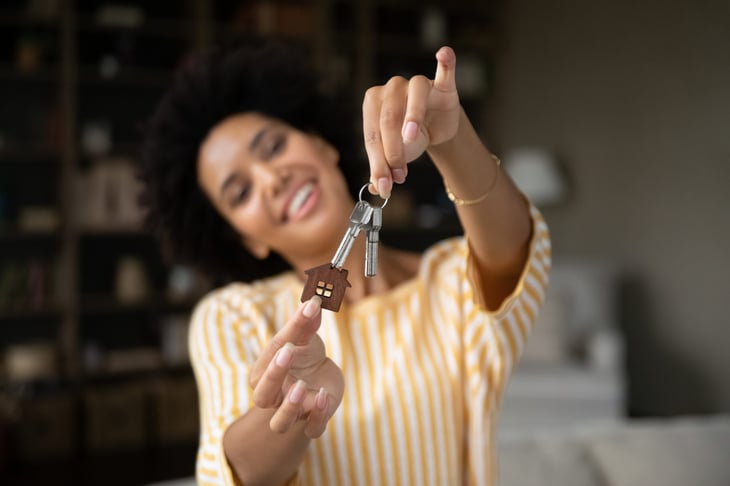
Editor's Note: This story originally appeared on Point2.
If you’re interested in putting your foot on the property ladder but don’t yet qualify for a mortgage, your dreams of homeownership aren’t quite over.
Considering a rent-to-own home makes it possible to circumvent conventional options.
But what is rent-to-own? In this guide, we’ll take a deep dive and discover how rent-to-own houses work, as well as what the various pros and cons are.
What Are Rent-to-Own Homes?

Rent-to-own homes are more or less what they sound like — potential buyers will first rent the home before eventually buying it. This program enables the buyer to build up the required funds and, if necessary, improve their credit score.
So, by the end of the lease period, they should be in a stronger position to obtain financing to buy the home.
The Rent-to-Own Process

When thinking about how to rent to own a house, the most straightforward comparison is to consider it a forced savings scheme. Each month, the tenant/buyer will pay rent to the current owner/seller as usual.
However, the rent will typically be higher than the market rate, with a chunk of it being saved toward a future down payment.
When you agree to rent to own a house, you and the seller will draw up a contract, typically known as either a rent-to-own agreement or a lease-option agreement.
The contract details the home’s agreed value, the lease period, the market rent price, and various other terms and conditions, as we’ll see.
1. Different Types of Contracts

There are two main types of rent-to-own contracts to choose from:
- Option-to-purchase contract: This is the most flexible option, as it lets you decide whether you want to purchase the home at the end of the lease. It’s also ideal if you’re not confident that the neighborhood will fit you well.
- Lease-purchase contract: This type of contract is typically preferred by sellers, as it ties the buyer into the deal — and at the end of the lease, buyers are obliged to purchase the home.
Be advised that while there are two broad types of contracts to choose from, the finer details can be adjusted indefinitely, making each individual contract unique.
So, make sure you go over the details with a professional to ensure your interests are protected.
2. Fees

Whichever rent-to-own contract you choose, you’ll be required to pay an up-front fee. This tends to be around 2% to 5% of the property’s appraised price and is typically either added to your down payment at the end of the lease or discounted from the final sale price.
It’s more or less a large security deposit that tells the seller that you’re likely to commit to the program.
However, it’s worth knowing that while the fee is usually at least partially refundable if you buy the home, you’ll almost always lose it if you pull out of the sale. This is true regardless of which type of contract you have.
3. Paying the Rent

Once you’ve paid the up-front fees, you’ll pay rent throughout the lease period like normal.
However, as mentioned, you can expect the monthly payments to be higher than the market rate. This is because a portion is put toward your future down payment on the home.
You can adjust the ratio to suit your circumstances, but as an example, 75% of your payment may go toward rent, while the remaining 25% gets saved each month.
You’ll also be able to determine how long the lease period will be. Typically, it’ll be between one and five years, giving you plenty of time to improve your credit score and save up for a decent down payment.
4. What Happens at the End of the Lease?

When the lease period ends, depending on the contract you opted for, you can either commit to buying the home or walk away. At this point, you should be able to obtain the necessary financing to buy the house.
The final asking price can be agreed upon and locked in either at the beginning or at the end of the lease period.
In the case of the latter, the home will be reappraised. Most buyers prefer to lock the price in advance to counter the frequent market fluctuations.
When Is a Rent-to-Own House a Good Idea?

Rent-to-own can be a fantastic choice if you’re serious about buying a home but need a bit more time before you can fully commit to the sale. It’s an excellent long-term option since you’ll be able to build equity while you’re just a tenant.
However, it’s not a good idea if the higher monthly rent will cause you financial difficulty.
Rent-to-own contracts often have strict penalties for late payments. In many cases, if you miss payments, the contract can be voided, and you can lose all the money you had previously invested.
It’s also important to be fairly sure you will purchase the home at the end of the lease. While an option-to-purchase contract allows you to walk away, you will lose the down payment you’ve saved throughout the program.
Rent-to-Own Pros and Cons

Rent-to-own programs tend to be geared toward serious buyers who cannot yet qualify for a mortgage. As such, there are several benefits to enjoy if you’re in this boat.
However, it’s not always without risk — going in unprepared could result in financial and legal trouble.
Rent-to-Own Advantages

- Flexible contracts: With an option-to-purchase agreement, you can pull out at any time without the obligation to buy. This is great if you want to give a particular neighborhood or home a test run.
- Easier to save for a down payment: Rent-to-buy homes force you to put money aside each month for a down payment, making it much easier to build up the funds.
- Time to fix poor credit: A more extended lease period can give you plenty of time to improve your credit score while ensuring that your dream home will still be on the market when you are ready to buy.
- Ability to lock in the asking price: This protects you against fluctuations in the market, meaning you could be paying less if property values rise in the future.
- Make yourself at home: With rent-to-buy housing, you’ll often have much more flexibility than regular renters. Generally speaking, you can maintain, decorate and renovate your home however you choose.
Rent-to-Own Disadvantages

- Potential loss of investment: If you don’t buy at the end of your lease, you’ll lose everything you’ve put into the home, equity and finances alike.
- More tenant responsibilities: Unlike a typical rental, the tenant is generally responsible for maintenance and repairs with rent-to-own rather than the landlord.
- Dependant on the landlord: Even though you’re investing in what you hope will be your future home while renting, it’s still in the landlord’s name. If they default on the mortgage, there’s a chance it could go into foreclosure.
- Potential to overspend: If you lock the asking price in at the start of the program and property values drop, you could end up spending more than the market rate.
- Strict penalties: Late payments are often met with harsh penalties. Be sure to check your contract thoroughly.





Add a Comment
Our Policy: We welcome relevant and respectful comments in order to foster healthy and informative discussions. All other comments may be removed. Comments with links are automatically held for moderation.